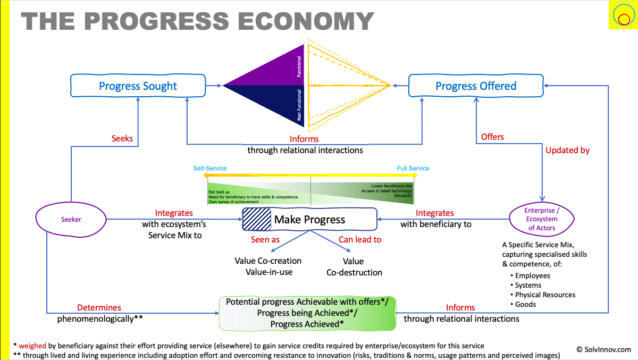The Big Picture…
Welcome to what I am calling The Progress Economy. The way of viewing the world that accelerates growth and innovation.
We can view The Progress Economy as three levels sitting on a simple set of fundamentals.

Fundamentally, we observe that:
- every actor is seeking to make progress with all aspects of their life.
- the way of working is service based built on-top of service-dominant logic.
- this world is inherently relational and feedback rules.
Above these fundamentals, we find three layers, describing:
- what is progress – it is sought, offered, has potential and is achieved. And has three components: functional, non-functional, and contextual progress.
- how is progress made – a seekers integrates their skills and competence with a particular service mix (resources that capture skills and competence) for a duration to make progress
- how progress is determined and by whom – uniquely and phenomenologically by the seeker; before, during and after the duration of the integration.
Importantly, we observe that value is relates to how much progress is made (it is not signalled by price).
Price still has a role. It signals the number of service credits the Enterprise wants in return for integrating with its service mix. It is a measure of survivability. For the seeker, price represents how much service they need to give, usually elsewhere, in order to get the necessary service credits. It can be see as effort.
Seekers decide with service mix to integrate with based on potential value they see in the progress offered, the effort they need to put in to get service credits, and the effort to integrate. They may cease integration at any time they feel not enough progress is being made.
Implications
We see that value is co-created and done so during use (the integration of resources). It may also be co-destructed.
Progress offered may attempt to match that sought. It is sufficient to match functional, better to match functional and non-functional, and best to match those plus contextual. But it may also under or over offer. Over offering may be strategic positioning. Or maybe the seeker isn’t aware they are looking for that progress yet. Under offering may be a cost play, identifying which elements of progress the beneficiary doesn’t necessarily need. Or it may be aligning with the true definition of disruptive innovation.
The layered model opens up clear opportunities for innovation.
The Idea
In attempting to address the innovation problem (and therefore fix the poor results we have with innovation today), I’ve identified one aspect we need to look differently at how value is created. That led me towards service-dominant logic, with its foundational premises shifting away from a value-in-exchange perspective (of what has subsequently become called good-dominant logic) to value-in-use and beneficiary determining value.
But this never sufficiently explained to me how things worked in a way that helped me systematically look for growth opportunities through innovation. Nor could I magic away the not insignificant role of price setting/cash.
Extrapolating tools, such as the service mix and service-service continuum helped. As well as identifying that service credits – a promise of future service – enable and mediate indirect service exchange. So price can be though of as a survivability aspect of the enterprise (ecosystem) – it needs a certain number of service credits to survive each integration (plus, often, profit). And price signals to the “beneficiary” not value, but effort they need to expend to get necessary service-credits to integrate with service mix they have chosen.
The true breakthrough came when seeing that actors were always seeking to make some progress, enterprises form to help make that progress, and ultimately, value relates to the amount of progress made. And hence The Progress Economy view was born.

The model is conveniently split into a set of fundamentals and three layers covering what is progress, how it is made, and who and how it is determined.
Innovation, which I’ll cover in a separate article, can come from any/all the levels. For example, offering better progress, altering the service mix, or reducing the effort the seeker perceives they need to perform to obtain service-credits (e.g. switching from up front costs, to, a monthly subscription model).
The Fundamentals
Fundamentally, we observe that all actors (person, group, enterprise, department..) are seeking to make progress in all aspects of their life.
the way of working is service based built on-top of service-dominant logic.
this world is inherently relational and feedback rules.
Level One – what is progress
Let’s call the actors seekers and the progress they seek: progress sought. Various enterprises/ecosystems form with the aim of offering to help seekers make progress in specific aspects. This we will call progress offered.
Where progress consists of three components:
- Functional (at an abstract level)
- Non-functional
- Contextual
And progress offered likely attempts to match progress sought. But validly may be over or under offered.
When matching to progress sought, it is weakly sufficient to understand just functional progress sought. It is better to include understanding of non-functional progress sought. And best if contextual is also included. All three brings us towards Christensen’s Jobs to be done theory.
Importantly, we can now see that potential progress and progress made are measures of value.
- Progress consists of three aspects:
- functional progress (at an abstract level, e.g. fill some time, rather than watch a streaming service)
- non-functional progress and
- contextual
- Enterprises/eco-systems form offering to help seekers make particular progress(es)
- This is Progress Offered
- And is offered as a service through a particular Service Mix – capturing specialised skills and competence (resource) in an Enterprise/eco-system specific combination of:
- Employees
- Systems
- Physical resources
- Goods (seen as a service, i.e. freezing skills and competence to be unfrozen at a different location/time)
- There is a relationship between Progress Sought and Progress Offered
- Progress Offered may attempt to match Progress Sought.
- At a minimum functionally; better functionally and non-functionally; and best functionally, non-functionally and contextually (this later is akin to Christensen’s Jobs to be done Theory).
- Progress Offered may be more than Progress Sought.
- Seekers may not yet be aware they are seeking this additional progress
- Enterprise/eco-system may be trying to differentiate themselves or find new classes of seekers
- Progress Offered may be less than Progress Sought.
- Enterprise/eco-system may be following a cost strategy (ala Porter)
- Enterprise/eco-system may be applying disruptive innovation (in the true meaning of the phrase)
- Relations between the seekers and eco-system informs the status of Progress Sought compared to Progress Offered
- Progress Offered may attempt to match Progress Sought.
Level Two – how is progress made
Enterprises provide acces to specialised skills and competences captured in a specific Service Mix of resources. Note that goods are seen as a distribution mechanism of service. And seekers attempt to make progress by integrating their resources (skills and competence) with a chosen service mix.
As resources integrate in an attempt to make progress, we say value is co-created and we get value-in-use. We also observe that value may be co-destructed, before, during, or after use.
A service-service continuum helps us understand what a particular servce mix means to a seeker. But we must be careful to understand that full service is not always “better” than self service. It depends on non-functional progress being sought.
A seeker chooses a service mix through evaluating a combination of
- potential progress – that is to say how the progress offered aligns to progress sought
- effort the seeker need to give (elsewhere) in service to gain the service credits to access resources (see definition of price below)
- effort the seeker has to put into integrating (including adoption, innovation resistance).
There is a fallback do-nothing option.
- Seekers integrate their resources (specialised skills and competence) with a chosen Enterprise/eco-system’s resoService Mix in an attempt to make progress
- Seekers can terminate the integration at any time they feel progress is not being met or is unlikely to be met in the future.
- Enterprise/eco-system may similarly terminate integration, but this is much less likely.
Level Three – how progress (value) is determined
Since it is the seeker attempting to make progress, it is they who uniquely and phenominologically determine value (potential progress and progress made).
In fact that determination is constantly done during the integration. And we observe that seekers will actively terminate integration if they are not getting the value (making the progress) they anticipate. Enterprises, less obviously, also re-evaluate their involvement, and in rare cases terminate integration.
It is important to understand that price is not an indicator of value. It is set by enterprise. But reflects service credits the enterprise requires to use its resources. Reflecting survivability of the enterprise. And is seen by the seeker as the effort required by them to provide their skills and competence – typically elsewhere than with the enterprise – to gain the necessary service credits. This is because service is the fundamental basis of exchange, but indirect exchange often masks this, and service credits mediate indirect exchange.
- Value is
- determined phenomenologically (lived and living experience) by the seeker – before, during and after integration (this is value-in-use).
- a measure of the amount of progress the seeker perceives can be, is and was made
- Value is co-created
- Value can be co-destructed
- this is Progress Achieved
- Price charged by Enterprise/eco-system is
- the amount of service credits the Enterprise/eco-system wants in order to allow its resources to be integrated with
- not a measure of value
- seen by Seekers as the amount of service they need to provide elsewhere in order to acquire the necessary service credits
- Seekers choose which service to integrate with based on:
- perceived Progress Achievable
- effort needed by them to gain required service credits
- effort needed to use service (adoption and resistance to innovation)
- the “do-nothing” option is valid
Relation to other economies
The goods economy
The traditional view of the economy, as per Adam Smith’s Wealth of Nations, is one that is based on goods and where services are not factors of growth. Such an economy is a restricted instance of The Progress Economy, where:
- the service mix is restricted to goods
- we forget that goods are a distribution mechanism for service
- the feedback loops in the progress economy are constrained in terms of the number of feedback mechanisms and the frequency
The service economy
Shift to the progress economy
I’ve discussed whether there is really a shit from goods to service economy previously. And found that no, there is not, there is merely a shift in the skills and competence we are seeking. I can translate that as there is a shift along the service-service continuum, i.e. an alteration in the service mix. In reality it has always been and will be a service economy (as goods are seen as a distribution – temporal and location – mechanism for service provision).
Is there a shift from service (or goods) economy to the progress one? No. As we see above, both those economies are instances of the progress economy.
